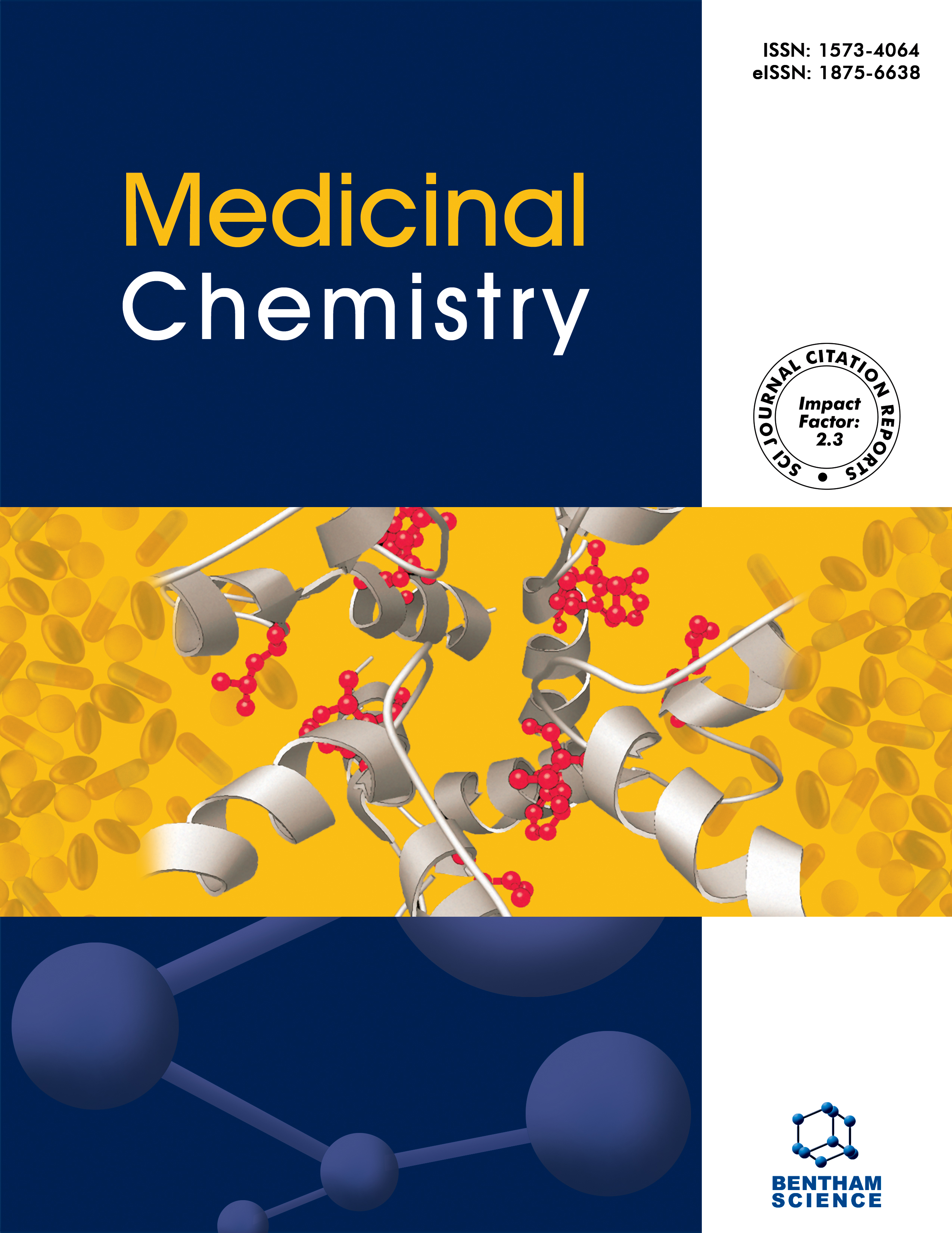- Home
- A-Z Publications
- Medicinal Chemistry
- Previous Issues
- Volume 18, Issue 7, 2022
Medicinal Chemistry - Volume 18, Issue 7, 2022
Volume 18, Issue 7, 2022
-
-
Mannich Bases: Centrality in Cytotoxic Drug Design
More LessMannich bases identified by Professor Carl Mannich have been the most extensively explored scaffolds for more than 100 years now. The versatile biological roles that they play have promoted their applications in many clinical conditions. The present review highlights the application of Mannich bases as cytotoxic agents, categorizing them into synthetic, semisynthetic, and prodrugs classes, and gives an exhaustive account of th Read More
-
-
-
Recent Update on the Development of Leucine-Rich Repeat Kinase 2 (LRRK2) Inhibitors: A Promising Target for the Treatment of Parkinson’s Disease
More LessAuthors: Ashish Patel, Stuti Patel, Meshwa Mehta, Yug Patel, Dhruv Langaliya, Shyam Bhalodiya and Tushar BambharoliyaParkinson’s disease is a relatively common neurological disorder with incidence increasing with age. Since current medications only relieve the symptoms and do not change the course of the disease, therefore, finding disease-modifying therapies is a critical unmet medical need. However, significant progress in understanding how genetics underpins Parkinson's disease (PD) has opened up new opportunities for understandi Read More
-
-
-
Abrogating Oxidative Stress as a Therapeutic Strategy Against Parkinson’s Disease: A Mini Review of the Recent Advances on Natural Therapeutic Antioxidant and Neuroprotective Agents
More LessAuthors: Thekla Theofanous and Malamati KourtiBackground: Reactive oxygen species (ROS) play a vital role in cell signaling when maintained at low concentrations. However, when ROS production exceeds the neutralizing capacity of endogenous antioxidants, oxidative stress is observed, which has been shown to contribute to neurodegenerative diseases such as Parkinson's disease (PD). PD is a progressive disorder characterized by the loss of dopaminergic ne Read More
-
-
-
Antioxidant and Antimicrobial Potential, BSA and DNA Binding Properties of Some 3-Hydroxy-3-Pyrrolin-2-Ones Bearing Thenoyl Fragment
More LessBackground: It is known that pyrrolidinone derivates belong to a class of biologically active compounds with a broad spectrum of biological actions. Nowadays, many scientists are making an effort in the discovery of more effective ways to eliminate reactive oxygen species (ROS) that cause oxidative stress or to eliminate the harmful microorganisms from the organism in humans. Therefore, pyrrolidinones seem to be great c Read More
-
-
-
2-Substituted Benzoxazoles as Potent Anti-Inflammatory Agents: Synthesis, Molecular Docking and In vivo Anti-Ulcerogenic Studies
More LessBackground: Non-steroidal anti-inflammatory drugs (NSAIDs) are the commonly used therapeutic interventions of inflammation and pain that competitively inhibit the cyclooxygenase (COX) enzymes. Several side effects like gastrointestinal and renal toxicities are associated with the use of these drugs. The therapeutic anti-inflammatory benefits of NSAIDs are produced by the inhibition of COX-2 enzymes, while undesirable s Read More
-
-
-
Water Mediated One-Pot, Stepwise Green Synthesis, Anti-Inflammatory and Analgesic Activities of (3-Amino-1-Phenyl-1H-Benzo[f]Chromen-2-yl) (1H-Indol-3-yl) Methanone Catalysed by L-Proline
More LessAuthors: G. G. Reddy, Ch. Venkata Ramana Reddy and B. Srinivasa ReddyAim: The reactions were carried out by one pot three-component synthesis, 3- cyanoacetylindole (1) on reaction with aromatic aldehydes (2) and β-naphthol (3) in an aqueous medium in the presence of L-proline as a catalyst under reflux for 30 min, resulting in (3-amino-1- phenyl-1H-benzo[f]chromen-2-yl) (1H-indol-3-yl)methanone (4). The method has many advantages like short reaction times, good yields, and simpl Read More
-
-
-
Bis-1,3,4-Oxadiazole Derivatives as Novel and Potential Urease Inhibitors; Synthesis, In Vitro, and In Silico Studies
More LessAuthors: Sana Shah, Momin Khan, Mahboob Ali, Abdul Wadood, Ashfaq Ur Rehman, Zarbad Shah, Muhammad Yousaf, Uzma Salar and Khalid M. KhanAims: To synthesize bis-1,3,4-oxadiazole derivatives as novel and potential urease inhibitors. Background: Despite many important biological activities associated with oxadiazoles, they are still neglected by medicinal chemists for their possible urease inhibitory activity. Keeping in view the countless importance of urease inhibitors, we have synthesized a new library of substituted bisoxadiazole derivatives (1-21) to evaluate t Read More
-
Volumes & issues
-
Volume 21 (2025)
-
Volume 20 (2024)
-
Volume 19 (2023)
-
Volume 18 (2022)
-
Volume 17 (2021)
-
Volume 16 (2020)
-
Volume 15 (2019)
-
Volume 14 (2018)
-
Volume 13 (2017)
-
Volume 12 (2016)
-
Volume 11 (2015)
-
Volume 10 (2014)
-
Volume 9 (2013)
-
Volume 8 (2012)
-
Volume 7 (2011)
-
Volume 6 (2010)
-
Volume 5 (2009)
-
Volume 4 (2008)
-
Volume 3 (2007)
-
Volume 2 (2006)
-
Volume 1 (2005)
Most Read This Month
Article
content/journals/mc
Journal
10
5
false
en


